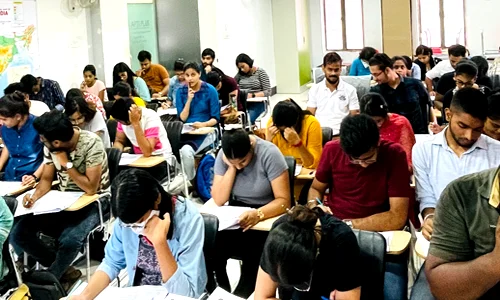



India’s capital markets are undergoing a major shift as domestic household savings increasingly replace foreign institutional money. This transition strengthens market stability and enhances policy autonomy but also exposes new retail investors to higher risks, uneven participation, and potential overvaluation. With rising SIP inflows, booming IPOs, and declining FPI dependence, markets appear strong on the surface, yet structural issues—such as unequal access, performance gaps in active funds, governance concerns, and growing wealth inequality—require urgent attention. Ensuring investor protection, financial literacy, and transparent regulation is critical for converting this savings shift into inclusive and sustainable financial growth.
Click to View MoreThe emerging priorities of India’s banking sector for 2025–2035 centre on strengthening deposit mobilisation to support rapid credit expansion, especially by deepening outreach in rural and semi-urban areas. Banks are shifting focus toward high-growth segments such as manufacturing, infrastructure, and renewable energy, while expanding green finance through sustainability-linked lending and support for technologies like Small Modular Reactors. Financial inclusion remains a core objective, with schemes such as PM MUDRA, PM Vishwakarma, PM Surya Ghar, PM Vidyalaxmi, and KCC enhancing grassroots access to credit. Agriculture lending is being redesigned under the PM Dhan Dhanya Yojana to boost productivity in low-performing districts. At the global level, banks are strengthening their presence through platforms like GIFT City and the India International Bullion Exchange. A parallel priority is improving customer experience through multilingual digital platforms and faster grievance redressal, reflecting a shift toward more technology-driven and citizen-centric banking.
Click to View MoreThe Credit Guarantee Scheme for Exporters is a government initiative providing collateral-free credit support of up to twenty thousand crore rupees to Indian exporters, including micro, small, and medium enterprises. By offering a 100% government-backed credit guarantee, the scheme enhances liquidity, promotes market diversification, strengthens global competitiveness, and supports employment. It aims to facilitate export-led growth, enable smoother business operations, and contribute to India’s journey towards becoming a self-reliant economy.
Click to View MoreIndia is working to build big and world-class banks to support its growing economy and global competitiveness. Reforms like the Indradhanush Plan, Atmanirbhar Bharat recapitalization, EASE reforms, and FSIB governance improvements have strengthened public sector banks. Digital innovations like UPI and Public Tech Infrastructure, along with the IFSC at GIFT City, position India as a leader in financial technology and global banking. The focus going forward is on capital adequacy, governance, digitalization, risk management, sustainability, and global integration to create banks that are efficient, resilient, and internationally competitive.
Click to View More
Artificial Intelligence (AI) is transforming the banking sector by enabling faster decision-making, improved customer experiences, and operational efficiency. However, it also introduces risks such as bias, model errors, data privacy issues, and regulatory challenges. AI auditing ensures these systems are ethical, transparent, and accountable throughout their lifecycle. Frameworks like RBI’s FREE-AI, along with global standards such as NIST AI RMF and CSA AICM, guide banks in implementing responsible AI. The way forward involves pragmatic guardrails, continuous monitoring, human oversight, and multi-stakeholder collaboration to balance innovation with risk, ensuring trustworthy and inclusive AI-driven banking.
Click to View MoreThe Kerala Single Dwelling Place Protection Bill aims to protect families from losing their homes due to loan defaults by preventing banks and financial institutions from seizing single dwelling properties under certain conditions. It covers loans up to Rs 5 lakh and provides relief to low-income borrowers with limited land and income. The bill establishes committees to review cases and allows the government to take over debts or absorb outstanding loans into housing schemes. This is a pioneering state-level effort following the Centre’s inaction on amending the SARFAESI Act to protect small borrowers.
Click to View MoreSmall Savings Schemes like PPF, NSC, SCSS, Sukanya Samriddhi Yojana, KVP, and MIS are government-backed instruments aimed at mobilizing household savings. As of Oct–Dec 2025, interest rates remain attractive (PPF 7.1%, SCSS 8.2%), ensuring investor confidence. Key initiatives include digitalization through Aadhaar-based e-KYC, freezing inactive accounts after 3 years, and exploring sachet-sized investments to promote financial inclusion. These measures enhance accessibility, transparency, and fiscal sustainability, making small savings schemes a safe and convenient investment option for all sections of society.
Click to View More
The 2025 Sa-Dhan report reveals a sharp rise in microfinance loan delinquencies across India, with 6.2% of loans overdue by more than 30 days—up from 2.1% in 2023–24. Bihar recorded the highest outstanding microfinance loans (₹57,712 crore) and the highest delinquency rate at 7.2%. Rural borrowers were most affected, with overdue rates exceeding those in urban areas, highlighting growing financial distress in rural economies and raising concerns over the sustainability of microfinance-led financial inclusion.
Click to View MoreIndia’s fintech sector has rapidly evolved through digital innovation, government support, and growing internet access—transforming payments, lending, and financial inclusion—while facing challenges like regulation, data privacy, and cybersecurity.
Click to View MoreIndia’s UPI expands to Qatar via Qatar National Bank and Qatar Duty Free, enabling seamless, real-time payments for Indian travelers. Driven by NPCI International, it boosts tourism, retail, and bilateral ties, showcasing India’s digital strength and advancing global payment interoperability.
Click to View MoreThe MSME sector is the backbone of the Indian economy, driving employment, innovation, and exports, but faces challenges related to credit access, technology adoption, and skilled workforce, requiring continued government support and focus on digitalization and sustainability for resilient growth.
Click to View MoreIndian Insurance sector is predicted to double to Rs 25 lakh crore by 2030, according to a report by IBAI and McKinsey & Company. The sector is crucial for economic growth, social security, financial inclusion, and national resilience. Government schemes like Pradhan Mantri Jeevan Jyoti Bima Yojana and PMSBY provide low premiums and risk coverage.
Click to View More
© 2025 iasgyan. All right reserved